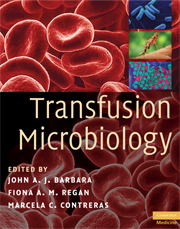Book contents
- Frontmatter
- Contents
- List of contributors
- Foreword
- Preface
- Acknowledgements
- Glossary
- Introduction: Transfusion-transmitted infections, then and now
- Section 1 Agents
- Section 2 Selection and testing
- 10 Blood donor selection and qualification
- 11 Current serological methods of testing and automation
- 12 Confirmatory testing and donor re-admission
- 13 The strategy for applications of nucleic acid testing
- 14 Nucleic acid testing: general view
- 15 Nucleic acid testing: the US approach
- 16 Nucleic acid testing: the UK approach
- 17 Quality in the screening of donations for transfusion-transmissible infections
- 18 Microbiological blood testing and new technologies
- 19 Processing and components: leucodepletion and pathogen reduction
- 20 Fractionated products
- Section 3 Surveillance, risk and regulation
- Index
- Plate section
- References
18 - Microbiological blood testing and new technologies
from Section 2 - Selection and testing
Published online by Cambridge University Press: 12 January 2010
- Frontmatter
- Contents
- List of contributors
- Foreword
- Preface
- Acknowledgements
- Glossary
- Introduction: Transfusion-transmitted infections, then and now
- Section 1 Agents
- Section 2 Selection and testing
- 10 Blood donor selection and qualification
- 11 Current serological methods of testing and automation
- 12 Confirmatory testing and donor re-admission
- 13 The strategy for applications of nucleic acid testing
- 14 Nucleic acid testing: general view
- 15 Nucleic acid testing: the US approach
- 16 Nucleic acid testing: the UK approach
- 17 Quality in the screening of donations for transfusion-transmissible infections
- 18 Microbiological blood testing and new technologies
- 19 Processing and components: leucodepletion and pathogen reduction
- 20 Fractionated products
- Section 3 Surveillance, risk and regulation
- Index
- Plate section
- References
Summary
Current testing methods: brief technology background
Current microbiological testing is discussed in detail in Chapters 11 and 12. Preventive measures, inactivation and microbiology testing as performed, at least in developed countries, guarantee an extremely safe blood supply (Barbara, 1998). Recently, a technologically demanding and conceptually different type of testing, NAT (discussed in Chapter 14), has been implemented as a routine procedure. In countries with high development indices, residual risk estimates, especially for transfusion-transmitted viruses, are very low (Soldan et al., 2003) and not many other medical procedures (if any) can match them. Of course, there is always room for improvement on safety: a level of automation to limit operator-related errors, cost-efficiency, etc.
In order to compare the power of current testing techniques with the potential of newly developed candidate next generation testing techniques, a brief summary of current testing technologies follows.
Unique features of microbiological blood screening
Various aspects of microbiological blood screening make it a rather unique process when compared with other testing procedures for infectious agents (see Table 18.1). Under usual circumstances people are tested for infectious agents on the basis of symptoms at or after a visit to a primary care physician, or during a stay in hospital. In other words, the physician or hospital microbiology laboratory personnel know what range of tests to perform on the basis of the referral or a preliminary diagnosis. Consequently, a large proportion of tested samples will give a positive result for one or more tested pathogens.
- Type
- Chapter
- Information
- Transfusion Microbiology , pp. 227 - 238Publisher: Cambridge University PressPrint publication year: 2008



